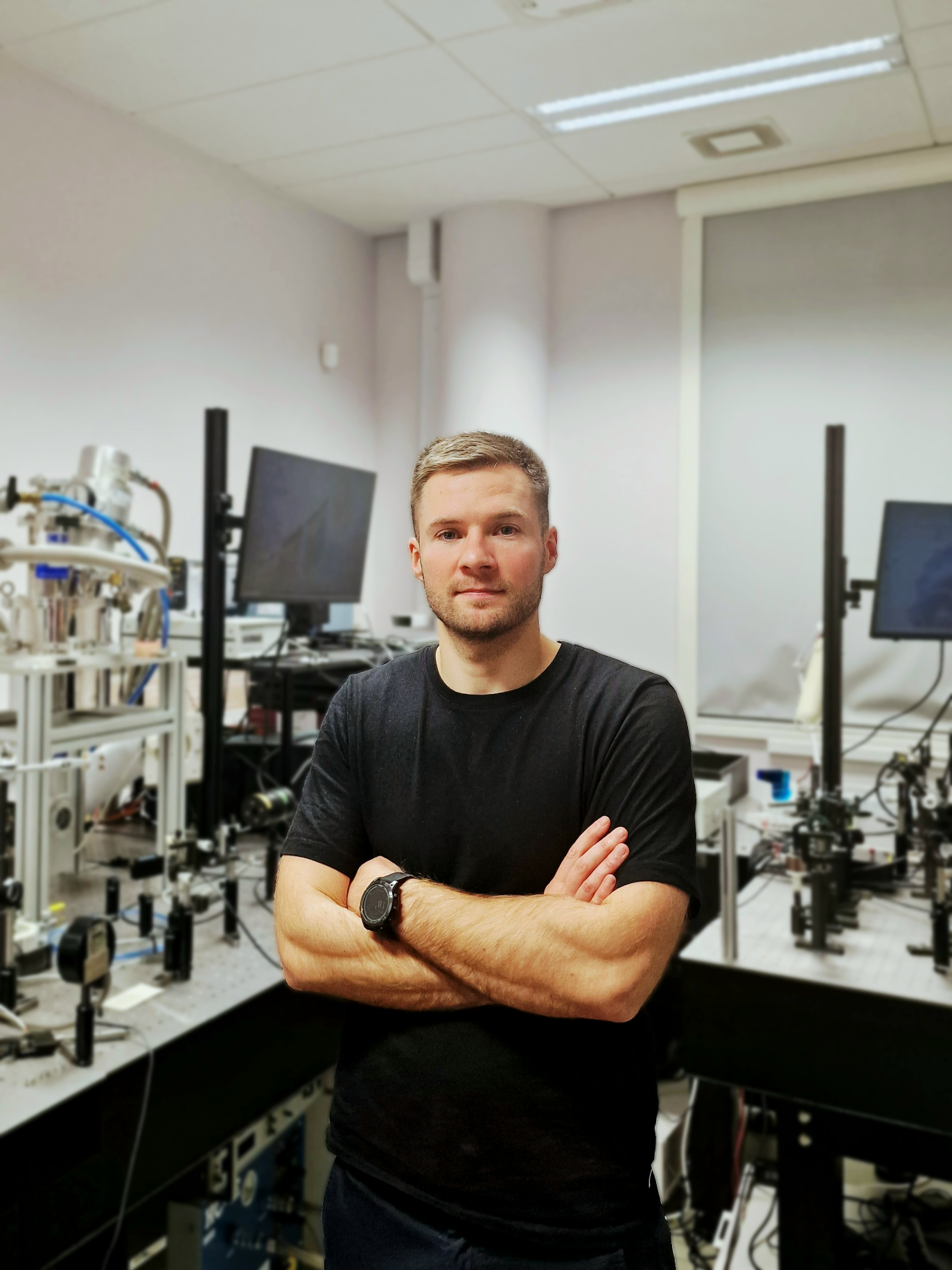VU Scientists’ Breakthrough: A Step Forward in Converting Infrared Light to Visible Light

A groundbreaking study from Vilnius University’s (VU) Faculty of Physics explores a highly promising method for increasing light energy. Using organic semiconductor technologies, Dr Edvinas Radiunas from VU’s Institute of Photonics and Nanotechnology, along with colleagues L. Naimovičius, Dr P. Baronas, Dr K. Kazlauskas, and others, has demonstrated how invisible infrared light can be converted into visible light. This unique research, aimed at harnessing light conversion phenomena in organic molecules, was published for the first time in the prestigious journal “Advanced Optical Materials”.
The Greatest Challenge in Optoelectronics
Dr E. Radiunas and his colleagues in VU’s Organic Optoelectronics Research Group are tackling an enormous challenge. They’re trying to find ways to manipulate light in unusual ways. The scientists aim to apply organic optoelectronics principles to increase light energy and, in the process, expand its practical applications in medicine, energy generation, and even 3D printing.
The task is so difficult and complex because light energy naturally decreases in materials. However, recent conversion research conducted by VU scientists (led by Dr K. Kazlauskas) and colleagues from VU’s Faculty of Chemistry and Geosciences (led by Prof. E. Orentas) is bringing a breakthrough closer.
In their publication, the scientists present a newly synthesised class of materials based on rubrene compounds, systematically modified with nitrile substituents. These materials were used to create organic layers that achieved record-breaking efficiency in converting infrared to visible radiation.
While increasing photon energy in inorganic materials like crystals or other nonlinear media is widely used and successfully applied in laser manufacturing and microscopy, it currently requires costly high-power pulsed lasers. As Dr E. Radiunas notes, organic light conversion offers a promising alternative because in such systems, the photon source isn’t as critical.
“Two-component organic compound systems can increase photon energy even under ordinary household lighting. This property opens up numerous innovative applications in the fields where powerful lasers, due to their cost and limited availability, are impractical and unnecessary,” he explains.
Why Is This Goal So Difficult to Achieve?
According to Dr E. Radiunas, efficiently increasing light energy on demand would create many new applications. For example, since organic light-converting layers work with sunlight, they could be integrated into solar panels.
Typically, single-junction panels optimally utilise only a limited portion of the light spectrum, as low-energy infrared photons aren’t absorbed and are therefore lost. A converting layer behind the solar cell could increase the energy of unused photons and return them to the panel, thereby increasing its efficiency. The scientists envision an organic dye layer that would boost the effectiveness of existing solar panels.
“Of course, practical application of such optoelectronic technologies is still quite far off. They require stable, solid materials. Developing new organic compounds that maintain desired properties in solid form is a highly challenging process. We’re fairly successful working with organic dye solutions. As long as the compounds are in solution, everything works well, but once you evaporate the solvent... the conversion efficiency drops. Together with colleagues, we’re modelling ways to preserve desired spectroscopic properties in solid form,” the scientist explains.
According to him, molecules in the solid state tend to either arrange chaotically or pack orderly. Predicting exactly how this will happen is very complicated. The final molecular arrangement significantly affects the layer’s photophysical properties, which can change in completely undesirable directions.
VU’s organic semiconductor specialists can predict with high accuracy which compounds to use and how to form layers with desired spectroscopic properties. They also work closely with chemists who cleverly advise where to add or “detach” atoms, changing the molecular structure.
“Working this way, the idea came that the rubrene compound could work perfectly. We’d use it as a base by attaching nitrile substituents. The tricky part is that there are many possibilities for attaching nitriles. In our models, we tested dozens of theoretical variations. Within about a week, our chemist colleagues had already prepared several material samples for testing. I began intensively studying the molecules and noticed that one compound looked quite promising both in solution and solid form. With our extensive experience in photon conversion and the necessary technological infrastructure in place, we successfully produced several prototypes and achieved excellent results. More precisely, the performance indicators were record-breaking,” Dr E. Radiunas recalls.
Promising Results from the Start
Dr E. Radiunas and his colleagues’ research resonated widely in the scientific community. Even before officially publishing the results, discussing the research at various conferences generated considerable interest.
“Implementing your ideas is always the hardest part. The influence of nitrile substituents on organic compounds is fairly well known. Their application is a difficult process, but we have talented chemists who can attach them exactly where others cannot. Then comes our physicists’ work – characterising and applying the new materials. The expectation that the idea could work was there from the beginning. The further we worked, the stronger that feeling became. From the first results, we saw that we’d discovered something important. But we really wanted everything to be maximally precise. That takes time. About two years passed from the start of the research until the article appeared,” he says.
This research is a continuation of the scientist’s doctoral dissertation, with knowledge gained during that process inspiring them. For now, he doesn’t dare predict where the research will lead, but it’s clear that the results obligate him to continue working, and he’s most curious to receive reactions from colleagues worldwide.
“Our older studies are very actively cited. That’s very gratifying and inspiring. This research is still a bit too fresh for that. We’ll see replications in articles that appear in a year or so. I won’t hide it – I’m really eager for more reactions. Especially since colleagues, while we were still conducting the research and announcing initial results at various conferences, frequently urged us to publish the article sooner. I’m very impatient for the full response to the research,” says Dr E. Radiunas.